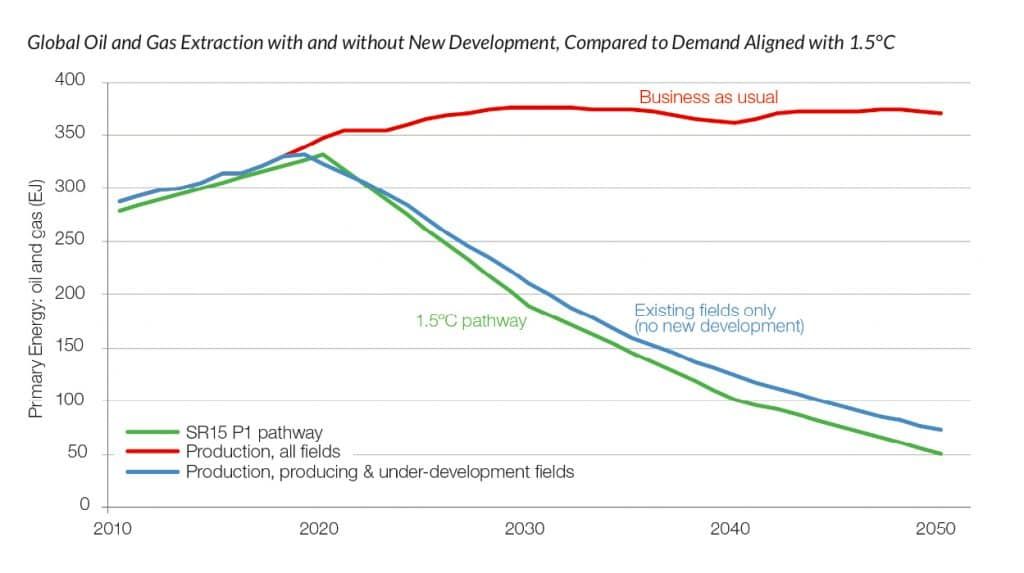A Cold War lesson for the climate change era: Why we need a Fossil Fuel Non-Proliferation Treaty
By Tzeporah Berman, Peter Newell, Matthew Stilwell | February 4, 2020
 Three possible futures are represented in this graph. Red is business as usual when it comes to fossil fuel exploitation, Blue is developing just existing fossil fuel reserves, and Green is the IPCC recommended pathway—which reduces emissions to net zero by 2050. Image courtesy of Fossil Fuel Non-Proliferation Treaty
Three possible futures are represented in this graph. Red is business as usual when it comes to fossil fuel exploitation, Blue is developing just existing fossil fuel reserves, and Green is the IPCC recommended pathway—which reduces emissions to net zero by 2050. Image courtesy of Fossil Fuel Non-Proliferation Treaty
Just like the accumulation of nuclear weapons, the continued buildup of carbon in the atmosphere—caused largely by the burning of fossil fuels—is a clear and present danger to life on Earth. In 2019, greenhouse gas emissions hit a record high, with the growth of oil and gas production cancelling out reductions in coal emissions. Taken together, coal, oil, and gas account for close to 80 percent of all carbon dioxide released since the Industrial Revolution. Consequently, a fossil fuel non-proliferation treaty is needed as urgently now as the Nuclear Non-Proliferation Treaty, or NPT, was 50 years ago (and indeed, continues to be needed, despite naysayers).
The world cannot afford to expand oil and gas production, as rising sea levels, hotter heatwaves, stronger and more frequent hurricanes, and endangered food supplies can attest. Yet money is still being funneled into extracting more fossil fuel, with $1.3 trillion going toward new oil and gas projects alone. According to a new analysis by the United Nations and other organizations, continued investments into this sector are placing the world on track to produce more than twice as much fossil fuels by 2030 than is allowed if we are going to limit the rise in global average temperature to below 1.5 degrees Celsius—placing the industry on a collision course with internationally agreed-upon climate goals, and the world on the path for catastrophic climate disruption.
Despite the mounting evidence of the catastrophic climate change that will occur if we do not change our current trajectory, it became clear that the vast majority of national governments are in denial as the UN Climate Change Conference in Madrid sputtered to a disappointing end in December 2019.
Faced with a growing climate emergency, action is urgently needed to tackle the proliferation of fossil fuels in modern society. But just as important as reducing the demand for fossil fuels—a major focus of the Paris Agreement—is reducing the supply, by curbing the expansion of oil, gas, and coal reserves and infrastructure, and phasing-out existing production. Unfortunately, supply-side policies have not been incorporated into international climate negotiations or into most national government plans.
This combination of fossil fuel production and weak climate leadership is already taking a deadly toll. More people are losing their homes due to climate change than war. Organizations as diverse as the Central Intelligence Agency and the World Economic Forum name the failure of climate mitigation and adaptation as one of the top threats facing the world.
Decades ago, nuclear war was identified as a threat to our collective future. During the height of the Cold War, nations came together to scale it down. They designed and implemented a treaty to phase out weapons of mass destruction, progressively disarm existing stockpiles, and encourage the peaceful use of technology. Through a variety of efforts, the world’s stockpile of nuclear weapons declined from a high of 64,449 nuclear missiles in 1986 to less than 10,000 as of the time of this writing.
Today it is known that the continued production and use of fossil fuels threatens the oceans, forests, water, air and stable climate on which life depends. There is no mushroom cloud, but climate change represents an existential threat that must be addressed through international cooperation.
Time for a new approach. UN climate negotiations alone are unlikely to result in the rapid decarbonization that is needed. Now is the time for a new international treaty to get to the root of the problem, by addressing fossil fuel supply—with wealthy nations moving first and fastest.
Drawing on the model of the nuclear treaty, a Fossil Fuel Non-Proliferation Treaty, like the nuclear treaty before it, would be constructed around three main pillars: non-proliferation, disarmament, and peaceful use.
Non-proliferation would prevent new exploration and production. This prevents the addition of unnecessary fossil fuels that lock-in catastrophic climate disruption, and it protects investments, workers and communities from becoming stranded.
Disarmament would phase out existing stockpiles and production to align fossil fuel supply with internationally agreed climate goals in the Paris Agreement.
Peaceful use of technology would fast track the transfer of clean, renewable energy to poorer nations, enable a just transition for workers and communities, and support economic diversification in fossil fuel dependent countries.
A significant source of funding for these efforts could come through the reallocation of trillions of dollars in subsidies that wealthy countries still give to the oil and gas industry—monies which could instead be spent on efforts to keep fossil fuels in the ground.
History shows that rapid, dramatic change is possible when a handful of countries are committed to lead. Imagine if wealthy nations were to step up and provide Ecuador and Peru an alternative to drilling in the heart of the region known as the Amazon’s Sacred Headwaters. This would avoid the release of 60 million tons of carbon, while respecting the rights of indigenous nations—and protect a vital organ of the Earth’s biosphere that is key to regulating the climate.
The advantages are significant.
A Fossil Fuel Non-Proliferation Treaty would raise awareness that the unabated proliferation of fossil fuels beyond safe climate limits represents an existential threat—much like nuclear weapons. Such a treaty would emphasize the need for concerted international cooperation to curb the supply of fossil fuels, operating hand-in-hand with the Paris Agreement’s focus on reducing demand and emissions. A Fossil Fuel Non-Proliferation Treaty would also provide a tangible proposal that individuals and organizations, cities and states, and national governments can rally around.
Focusing on the production and supply of fossil fuels complements and reinforces demand-side efforts. It limits the potential for “locking-in” future production, emissions, and global heating. It liberates the resources needed to fast-track other reliable, affordable, and low-carbon solutions. And it is cost-effective and practical, given that the emphasis would be upon a limited number of actors, companies, and facilities.
Our current path, in which we expand the production of fossil fuels, is akin to the fire department showing up with gasoline to save a planet on fire. This cannot continue.
Our children understand the risks. They are marching in the streets, demanding that science not be ignored so there is a chance for a future. We must heed their call. It’s critical that governments both strengthen the Paris Agreement on climate change, and face the need to limit the proliferation of fossil fuel production. It’s time to propose solutions commensurate with the scale of the challenge.
(Editor’s note: The authors of this editorial are convening lawyers and climate policy experts to develop the Fossil Fuel Non-Proliferation Treaty.)
Together, we make the world safer.
The Bulletin elevates expert voices above the noise. But as an independent nonprofit organization, our operations depend on the support of readers like you. Help us continue to deliver quality journalism that holds leaders accountable. Your support of our work at any level is important. In return, we promise our coverage will be understandable, influential, vigilant, solution-oriented, and fair-minded. Together we can make a difference.


















Climate change is clear and present danger, an existential crisis, and Berman, Newell, and Stillwell are pushing for renewables without even mentioning nuclear power? Ms. Berman should know better — Ontario is has one of the lowest electric generation carbon intensities in the world. Can The Bulletin send the authors to Germany so they can see how well their strategy is working there?
Excellent article! A puzzling aspect of the climate debate is the persistence of promotion of nuclear power (e.g. Blomquist’s comment) in the face of its limitations in terms of delivery timescale and cost of production. Science informs us that the world must become carbon neutral by about 2050 to keep warming below 2C and before about 2030 for 1.5C. Yet, for a country without nuclear power, it would take about 15 years to plan, build and commission the first nuclear power station of a type that’s commercially available. Even in countries with the technology and infrastructure, new nuclear power stations… Read more »
France and Sweden mostly decarbonized their electricity sectors in something like 15 years. Due to the need for grid enhancements to make wind and solar a feasible alternative, it would probably take longer for them to decarbonize our electricity. The need for fossil backup us surely why the fossil fuel industry (especially gas) supports wind and solar — they would lock in demand for gas for decades. W&S would also likely be hugely more expensive when adding in the external costs that the electricity system would incur over and above the generators. Perhaps Mr. Diesendorf can provide examples of the… Read more »
When I look at the graph in this article there does not seem to be a substantial difference between the blue and the green line. Either would be a terrific improvement over the current.
Dr. Sparks Lunney
Retired
Former Adjunct Professor CUNY, SUNY, Edison College, Naples, Florida
& 2006 Auguste Rodin Award recipient Edison College, Naples, Florida